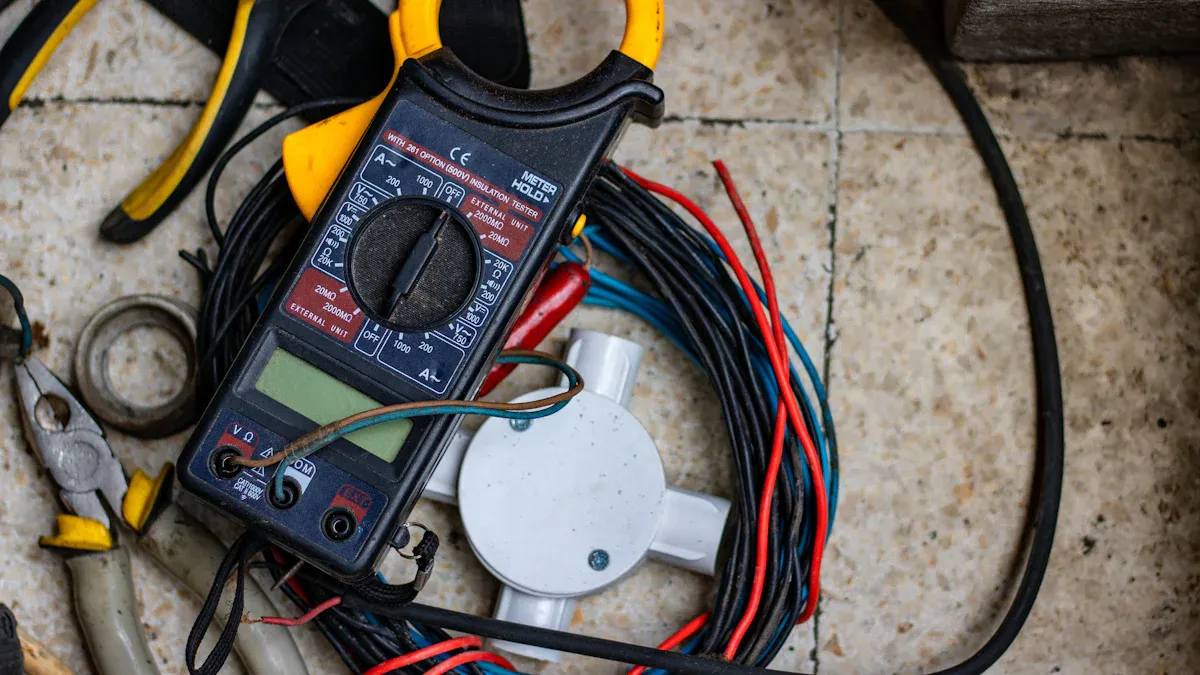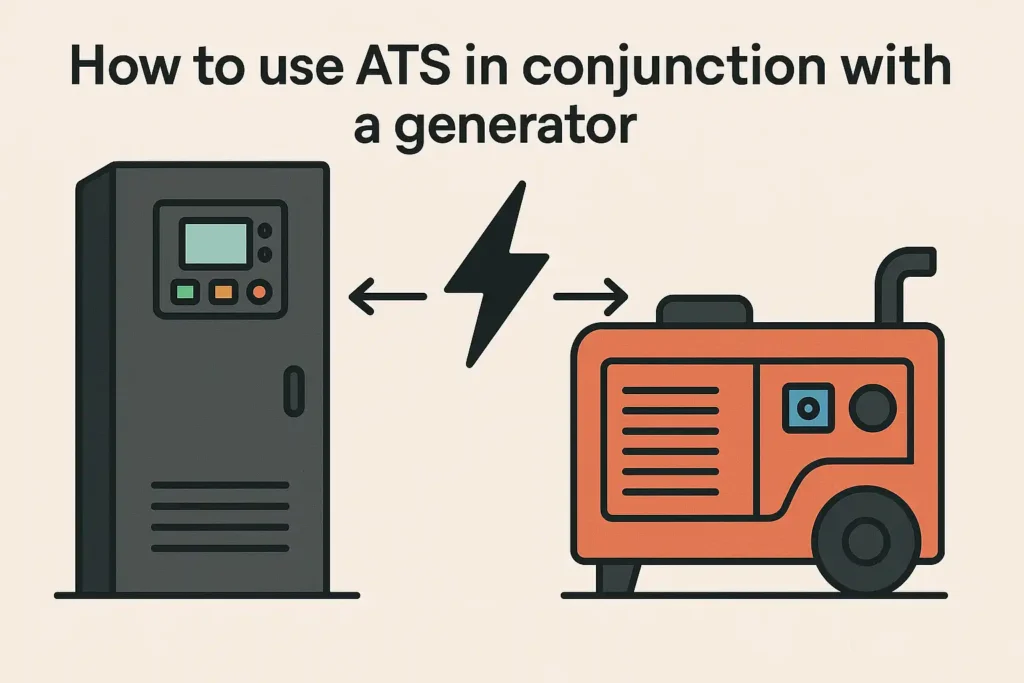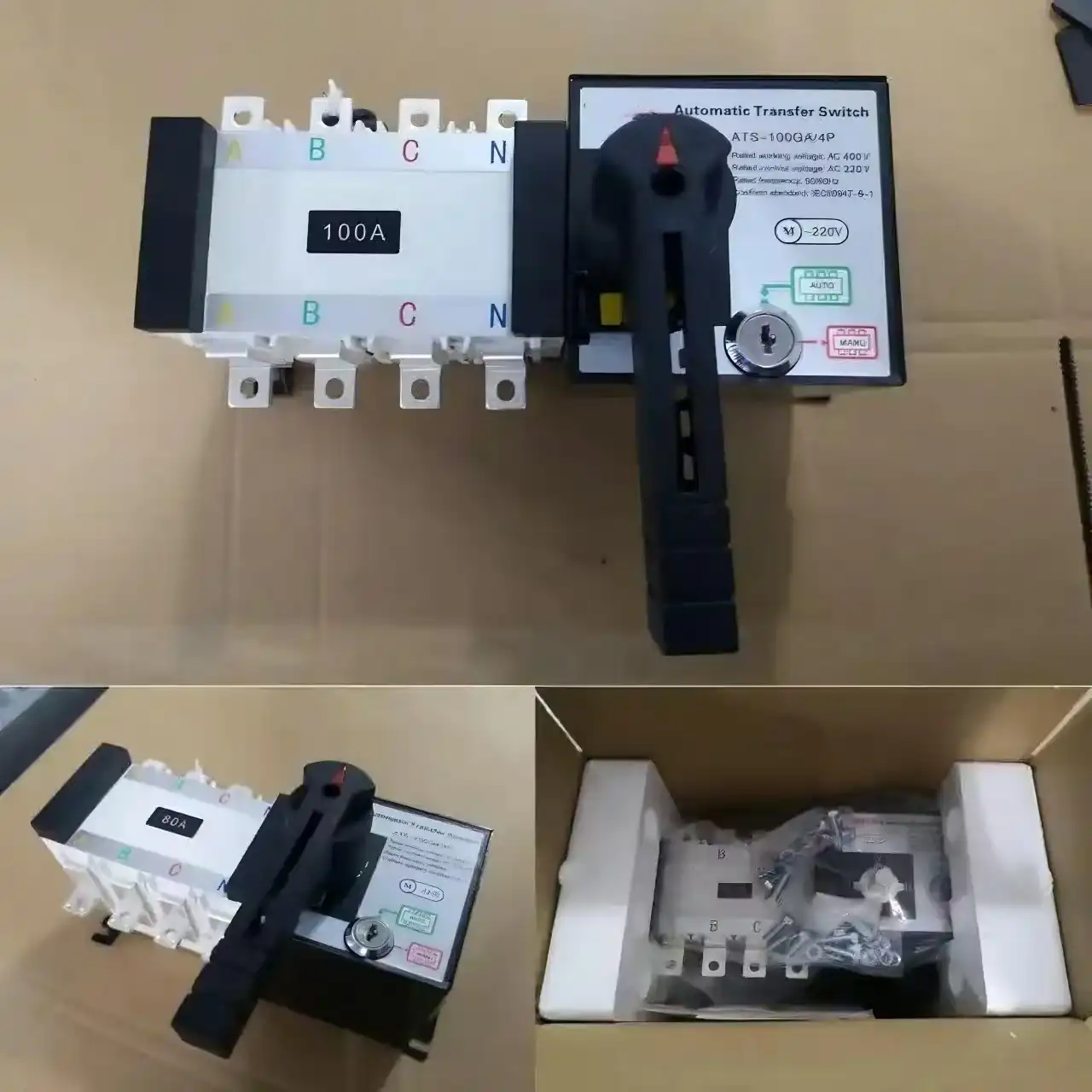You use an automatic transfer switch to connect your generator safely. This device stops dangerous back feeding. It keeps utility workers safe from getting shocked. Many people get hurt or start fires if they skip this step.
- Common risks include:
- Carbon monoxide poisoning from bad airflow.
- Getting shocked from back feeding.
- Fire danger from too much power or spilled fuel.
- Burns from touching hot generator parts.
Always read your owner’s manual and check local rules before you begin.
| Aspect | Professional Installation | DIY Installation |
|---|---|---|
| Total Cost | $400 to $2,500 | Lower, but more dangerous |
| Safety & Compliance | Licensed and insured | More chance of mistakes |
Key Takeaways
- An automatic transfer switch helps keep your home safe. It stops dangerous backfeeding. It also protects utility workers from harm.
- The ATS switches your power to the generator during outages. This gives you backup power fast and easily. You do not need to do it by hand.
- You must install the ATS near your main panel. You should follow safety rules to avoid shocks, fires, or damage.
- Test and maintain the ATS and generator often. This helps find problems early. It keeps your system working well.
- Always follow local codes for safety. You should think about hiring a licensed electrician. This makes sure your setup is safe and legal.
Automatic Transfer Switch Basics
What Is an Automatic Transfer Switch
An automatic transfer switch lets you change from main power to a generator. It helps your house stay powered when the electricity goes out. You do not need to flip breakers or plug in cords. The switch does this job for you. When the main power stops, the switch moves your home’s power to the generator. When the main power comes back, it switches back again.
There are different types of automatic transfer switches for homes. Most homes use the open transition type. This kind cuts off the main power before turning on the generator. You might see a quick flicker or short blackout. This is normal and safe for most things in your house.
| ATS Type | Description | Typical Use |
|---|---|---|
| Open Transition ATS | Break before make; brief power interruption during transfer. | Common in homes |
| Closed Transition ATS | Make before break; no power interruption, but more complex and costly. | Used in places needing seamless power |
| Soft Loading Transfer | Adjusts load smoothly; higher cost. | Business settings |
| Bypass Isolation ATS | Allows maintenance without power loss; most complex. | Critical environments like hospitals |
How It Works
The automatic transfer switch checks your main power all the time. It uses sensors to watch the voltage and frequency. If the power drops or stops, the switch tells your generator to start. After the generator warms up, the switch moves your house’s power from the main source to the generator. You get power again in just a few seconds.
Here is how the main parts work together:
| Component | Function |
|---|---|
| Transfer Switch Mechanism | Connects or disconnects power sources. |
| Automatic Source Sensing | Detects power failures and starts the transfer process. |
| Control Circuitry & Monitoring | Makes sure everything runs smoothly and shows real-time status. |
| Power Distribution Connections | Sends power to your home’s circuits. |
The switch keeps your house on generator power until the main power is back. When the main power is steady, the switch moves your house back to it and turns off the generator. This keeps your appliances safe and protects your family.
Tip: Pick an automatic transfer switch that fits your generator and your house. This helps stop overloads and keeps your system safe.
Why Use an ATS
Safety
You want your house to be safe when the power goes out. An automatic transfer switch helps keep everyone safe. It stops backfeeding, which can send power into the lines. This keeps utility workers safe if they are fixing wires near your house. Your family and your appliances are also safer from shocks and power surges.
Many people pick an automatic transfer switch for safety:
- It stops backfeeding, which can hurt people or break things.
- It keeps electronics safe from sudden changes in power.
- It only powers the circuits you choose, so you do not overload.
- It helps you follow local electrical rules and codes.
Note: Using an automatic transfer switch is a great way to make sure your generator setup is safe.
Convenience
You do not want to go outside in bad weather to start your generator. With an automatic transfer switch, you do not need to. The switch knows when the main power is out. It starts your generator and moves your house’s power to it by itself. You get power back in just a few seconds, even if you are not home.
Here are some ways an automatic transfer switch makes things easier:
- It finds power loss and switches to the generator by itself.
- It switches back to main power when it is safe, with no work from you.
- It works even if you are not home, so your house stays powered.
- It keeps your appliances running and cuts down on downtime.
- It lowers the chance of mistakes that can happen with manual switches.
Tip: Hospitals and data centers use automatic transfer switches because they cannot lose power. You can use this technology to keep your home safe too.
Installation Steps

Preparation
Before you begin, gather all the tools and materials you need. Work safely and follow your local rules. Always turn off the main power at the breaker panel before starting.
Here are some tools and materials you should have:
- Generator transfer switch kit
- Electrical cable and wire
- Electrical conduit and fittings
- Drill and drill bits for cable and conduit
- Multimeter or voltage tester
- Flathead and Phillips-head screwdrivers
- Adjustable wrench and Allen wrench set
- Wire cutters and wire strippers
- Pliers
- Insulated electrician’s gloves
Tip: Only use tools with insulated handles. Do not use all-metal wrenches to help prevent shock.
Choose a spot for the automatic transfer switch near your main electrical panel and generator. The place should be dry and have good airflow. It should also be easy to reach for repairs. If your area floods, put the equipment above where water might reach. Keep the generator outside, away from windows and doors. This helps stop carbon monoxide from getting inside. Place the generator on a flat, fireproof surface. Make sure there is enough space for air to move around it.
Note: Most portable generators do not work with an automatic transfer switch unless the maker says they do. Usually, portable generators use a manual transfer switch instead.
Connecting the ATS
Follow each step to connect the automatic transfer switch safely. Always wear insulated gloves and safety gear.
- Turn off the main power at the breaker panel.
- Put the automatic transfer switch on the wall near the main panel. Make sure it is straight and tight.
- Use the wiring diagram from the maker. Connect the circuits you want to back up to the transfer switch. Check each connection to make sure it is tight and covered.
- Run conduit and wire from the transfer switch to the main panel and the generator. Hold all cables in place and look for damage.
- Connect the transfer switch to the utility power and the generator. Make sure all wires are grounded and safe.
- Look at all connections for rust, dirt, or loose wires. Tighten and clean them if needed.
⚡ Common mistakes are loose wires, wrong size switches, and not checking for hazards. You can avoid these by checking each step, using the right size switch, and keeping the area clean and dry.
Testing and Operation
After you finish, you need to test the system to make sure it works.
- Look at the automatic transfer switch and wires. Check for heat, shaking, dirt, or damage.
- With all power off, check the insulation and moving parts. Make sure everything is tight and lined up.
- Test the manual switch. Move the handle to see if it works well.
- Pretend there is a power outage by turning off the main breaker. Start the generator. Watch the automatic transfer switch move power to the generator. Make sure the right circuits get power.
- Turn the main power back on. The switch should move power back to the utility and turn off the generator after it cools down.
- Listen for strange sounds or shaking. Check the lights and timers to see if they work right.
- Clean the switch with a dry cloth or vacuum. Do not use blowers, as they can push dirt inside.
- Write down your test results and save them for later.
Tip: Test your automatic transfer switch every month. Look at it every week for dust, rust, or loose parts. If you find a problem, call a licensed electrician.
If you follow these steps, your generator and automatic transfer switch should work safely and well. Always follow the maker’s instructions and local rules. If you are not sure what to do, ask a professional for help.
Safety and Compliance
Electrical Safety
You must be careful when using an automatic transfer switch. Electricity is very dangerous if you do not use it right. It can hurt or even kill you. Always think about safety first.
Here are some important electrical safety tips:
- Turn off the main power before you start working.
- Use a double-pole, double-throw (DPDT) transfer switch to stop backfeed.
- Make sure all wires follow the National Electric Code.
- Ground the generator and switch to stop shocks.
- Keep the generator and switch dry at all times.
- Ask a licensed electrician to install the system for you.
- Turn off all devices before you plug them in. Turn them on one by one.
- Run the generator outside where air can move. This stops carbon monoxide from building up.
- Use the right extension cords and do not plug in too much.
- Keep a fire extinguisher close by.
- Store fuel away from the generator. Never add fuel while it is running.
⚠️ Always read the instructions for your automatic transfer switch and generator. If you are not sure what to do, call a professional.
Code Requirements
You have to follow national and local rules when you install an automatic transfer switch. These rules keep your house safe and help you stay out of trouble.
- The National Electrical Code (NEC) Articles 701 and 702 give the main rules.
- Article 701 is for systems that must work for safety, like fire alarms.
- Article 702 is for backup systems in homes and businesses.
- Both articles say you must stop utility and generator power from mixing.
- You need clear signs to show where backup power comes from.
- All systems must be grounded and bonded the right way.
- Local rules may have more steps. Always check with your city or county first.
- Only licensed electricians should do the work. This keeps you safe and your insurance good.
Note: Following these rules makes sure your automatic transfer switch works right during power outages and keeps you legal.
Maintenance and Troubleshooting
Regular Checks
You need to keep your automatic transfer switch and generator in good shape to make sure they work when you need them. Regular checks help you catch small problems before they turn into big ones. Here are some important tasks you should do:
- Look at the outside and inside of the switch every month. Check for dust, dirt, or signs of heat like discoloration or cracks.
- Make sure warning labels and signs are clear and easy to read.
- Check all wires, connectors, and insulation for wear or damage.
- Clean the switch only after turning off all power. Use a soft brush or dry cloth. Do not use compressed air.
- Inspect contacts for corrosion. Replace them if you see pitting or erosion.
- Test the manual handle to make sure the switch moves smoothly between power sources.
- Keep the area around the switch and generator dry and free from clutter.
- Schedule a professional inspection once a year. A trained electrician can use special tools to check for hot spots, test the system, and recalibrate settings.
Tip: Running these checks helps your system last longer and keeps your home safe during outages.
Common Issues
Sometimes, problems can happen even if you take good care of your system. Here are some common issues you might face with an automatic transfer switch:
- Overloading the generator by trying to power too many circuits at once. This can cause the system to shut down or damage equipment.
- Power surges when utility power comes back. These surges can harm your appliances.
- Human error, like switching power sources the wrong way, can cause safety risks. The automatic transfer switch helps prevent this by handling the process for you.
If you notice any of these warning signs, you should call a professional:
- Loose connections that you cannot tighten safely.
- Parts that do not move or feel stuck.
- Signs of corrosion, overheating, or burnt smells.
- The switch fails during a test or does not transfer power as it should.
- Any error messages or alarms from the system.
⚠️ Always ask a licensed electrician for help if you see these problems. Regular maintenance and quick repairs keep your system reliable and extend its lifespan.
You can keep your home safe and powered by following these steps when using an automatic transfer switch:
- Mount the switch near your main panel.
- Turn off all power before wiring.
- Connect the switch wires to the correct breakers.
- Place the generator outdoors, at least 20 feet from your home.
- Test the system after setup.
Regular checks and following local codes help prevent accidents. If you feel unsure, ask a licensed electrician for help.
Choose ONESTOP automatic transfer switch: With over 20 years of manufacturing experience, international certification assurance, and excellent quality, we help you comprehensively improve circuit safety protection.
FAQ
Can I install an automatic transfer switch myself?
You can install it if you have electrical experience. Most people should hire a licensed electrician. This keeps you safe and helps you follow local codes.
How often should I test my automatic transfer switch?
Test your switch once a month. Run a full system test every three to six months. Write down the results in a logbook.
Will an ATS work with any generator?
No. You need a generator that matches your switch’s size and type. Always check the manufacturer’s instructions before you buy or connect anything.
What happens if the ATS fails during a power outage?
If the switch fails, your generator will not power your home. You should call a licensed electrician right away. Keep flashlights and batteries ready as a backup.
The following information may be of interest to you
Manual or Automatic? Decide on Your 200 Amp Transfer Switch
Selection guide for three-phase automatic transfer switch
The Best Automatic Transfer Switch for Solar Energy in 2025
How to wire a 50 ampere automatic transfer switch





